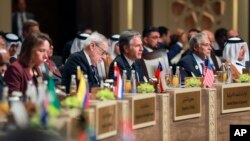U.S. Secretary of State Antony Blinken meets Wednesday with Qatari Prime Minister Sheikh Mohammed bin Abdulrahman Al Thani as U.S., Qatari and Egyptian officials evaluate Hamas’ response to a proposed multistage cease-fire in Gaza.
John Kirby, White House national security communications adviser, told reporters that Hamas delivered its response to Qatar and Egypt Tuesday, and that the United States assumes the response has the approval of the top Hamas leader in Gaza, Yahya Sinwar.
Kirby declined to give much detail, citing the risk of upsetting the negotiation process.
“There's a whole heck of a lot riding here, a whole lot at stake, and not the least of which – in fact, the most important of which – is the lives of these hostages and their families,” Kirby said. “We need to be very, very careful about what we say and how we say it.
According to Hamas and the smaller Islamic Jihad militant group, they are ready to "deal positively to arrive at an agreement," prioritizing a "complete stop" to the war.
"The Hamas response reaffirmed the group's stance any agreement must end the Zionist aggression on our people, get the Israeli forces out, reconstruct Gaza and achieve a serious prisoners swap deal," a Hamas official said.
U.S. President Joe Biden publicized details of the cease-fire proposal, while he and other U.S. officials have repeatedly stressed it is an Israeli proposal. Blinken said Tuesday that Israeli Prime Minister Benjamin Netanyahu reaffirmed his commitment to the deal.
There remain potential points of contention, including the Hamas demand that Israel withdraw its forces from Gaza, and Israel’s stated commitment to its goal of defeating Hamas and ensuring the militant group cannot launch any future attacks on Israel.
In its initial phase, the three-phase cease-fire proposal calls for a halt in fighting, the release of some hostages from Gaza, the release of some Palestinian prisoners held by Israel, a surge in humanitarian aid for Palestinians, the withdrawal of Israeli troops from populated areas of Gaza, and the return of Palestinian civilians to their homes and neighborhoods.
Families and supporters of Israeli hostages held by Hamas in Gaza hold banners and flags during a protest calling for their return, outside meetings of U.S. Secretary of State Antony Blinken in Tel Aviv, Israel, June 11, 2024.
The second phase envisions a permanent cessation of hostilities in exchange for the release of all other hostages in Gaza and a full withdrawal of Israeli troops from Gaza.
The final phase includes a multi-year reconstruction plan for the Gaza Strip, much of which has been devastated by eight months of Israeli bombardment. It would also provide for the return of the remains of any deceased hostages still in Gaza.
Israel’s military reported Wednesday carrying out ground and air attacks in the central Gaza Strip and in the southern city of Rafah.
Israel also said it struck targets in southern Lebanon after Hezbollah militants launched more than 150 rockets into northern Israel.
The Hezbollah attack was in retaliation for Israel’s killing Tuesday of a senior Hezbollah commander.
The two sides have traded near-daily cross-border fire throughout the war in Gaza, raising fears of a widening regional conflict.
The October 7 Hamas terror attack resulted in the deaths of about 1,200 people in Israel, mostly civilians, according to official Israeli figures. Hamas militants took about 250 hostages, 116 of whom remain in the Palestinian territory, including 41 the army says are dead.
Israel's military response has killed more than 37,000 Palestinians, according to Gaza's health ministry, which does not distinguish between fighters and civilians in its figures.
State Department Bureau Chief Nike Ching contributed to the report. Some information for this report came from The Associated Press, Reuters and Agence France-Presse.





Forum